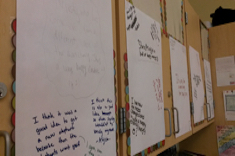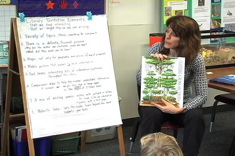Recently, I sat in the midst of my classroom’s nonfiction library looking at books scattered across the floor. Fiction books were piled onto empty nonfiction shelves. When I looked at these books and revisited my observational notes, I realized that (once again) students simply grabbed books for independent reading sessions and abandoned the books almost as quickly as they “found” them.
Dismayed, I pondered, What am I going to do to sustain readers’ interests?
Then I remembered the value of magazines. I have not used magazines widely in my classroom for years, until recently when Peter reminded me of what so many boys need to read.
Peter’s Story
Peter’s older sister read every book in the classroom library during her tenure in my class. Peter, a year younger, discreetly read most of the books his sister brought home, but nothing of his own selection. When Peter entered my class, the number of chapter books he read dropped off dramatically.
Peter emulated his sister’s reading and met minimal expectations for reading, but he did not enjoy fiction. When Peter and I sat down with his parents to kick-start his reading, we quickly realized he preferred relevant, fact-laden, and current material. I floated the idea of reading stories and feature articles in news magazines to Peter and his parents. Peter almost instantly committed to reading an article a day. Thus was born the idea of encouraging Peter to read an article a day, known in my classroom as #articleaday. This title was adapted from Donalyn Miller’s #bookaday hashtag and Kelly Gallagher’s strategy of reading a nonfiction article each week with his high school students.
Feature articles in a magazine often require rigorous reading. As adults, we choose to read feature articles or cover stories, for a variety of purposes. Many of us enjoy reading feature articles for pleasure. We might sit down and read an article from the Atlantic or the New Yorker as a mode of self-care. Maybe we are looking for anecdotes from Psychology Today or facts from Rolling Stone we can use for content lessons.
When intermediate students are struggling, shorter readings can create confidence. To sit down and feel the accomplishment of reading printed matter, beginning to end, while learning or retaining content, creates empowerment. The task seems manageable, as “I have to read” is replaced by “I can read my magazine.” I have found reluctant readers are likely to revisit and hold on to an endearing magazine more often than they are a book.
Assimilating #articleaday into Daily Reading
Implementing #articleaday is simple as long as two conditions are in place: access to magazines and willingness to let go of a limited view of what qualifies as acceptable reading material. Using #articleaday helps alleviate the perception that only books can be read in school. Not every student will venture down the #articleaday path, but for those who do, continual access to magazines sustains their interest.
Magazine articles aren’t necessarily as easy to quantify as chapter books, which changes requirements such as “pages-per-day” or “one book-per-week.” A typical sixth-grade student should be able to read two or three articles in a single 45-minute sitting. A more reluctant reader can read a single article in a sitting and feel successful.
I promote feature articles and cover stories as the most desirable content to read from a magazine. Magazines are great for 100-200 word columns or “departments” that capture interest and offer volumes of information. We love reading columns or the graphics with which magazine publishers frontload or end their periodicals. However, the emphasis with this reading strategy is to create sustained reading with short materials. Therefore, I encourage students to spend time with two or three feature articles for reading in the classroom and at home. After all, isn’t a full-length article like a chapter in a book?
Budgeting for Magazines
Magazines have a short shelf life. Is the expenditure worth it? There will always be a few popular magazines that readers love, making the investment worthwhile. Sports Illustrated is an example.
Magazines can offer a longer-range investment. For example, my text and periodicals budget for an entire school year is $104. Knowing that I will purchase books for my classroom, I use the classroom budget to purchase magazine subscriptions. Most magazines purchases are weekly, but subscriptions can be purchased for two or three years. In my first year of budgeting, I can order five or six subscriptions, investing for the next year or two. The cost of these subscriptions is quite low, as publishers struggle to keep their subscriber base.
Favorite Classroom Subscriptions
Time
US News and World Report
Newsweek
Sports Illustrated
Sporting News
Food Network
Cooking Light
Better Homes & Gardens
Mother Earth News
Free magazines also go a long way, even though many of them have special-interest themes. In my area, the Chamber of Commerce releases a magazine every year. They are free at every bank, grocery store, and convenience store in town. Including a magazine like this helps readers see material that is read throughout the community. You can also ask for donations from families.
Encouraging students to read an article a day helps them sustain reading, at school and home. Cover story and feature articles in magazines can entice readers like Peter, who might otherwise need a change of pace in their reading lives. The short texts are inviting, and the nonfiction topics draw them in.









